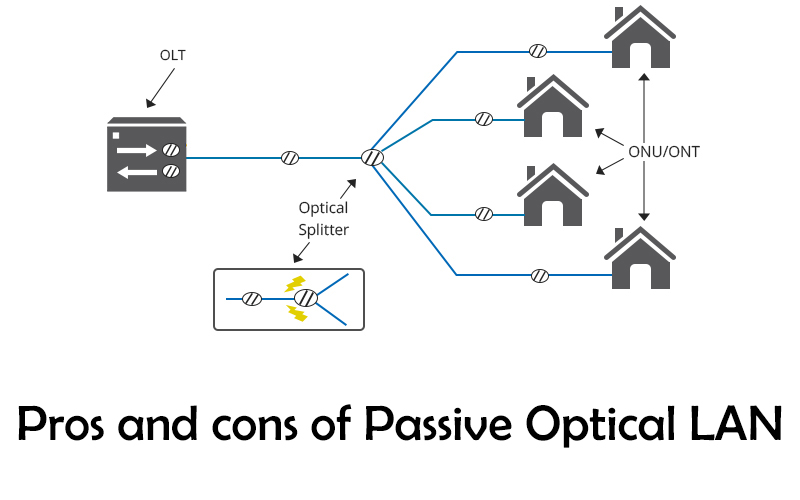What is passive optical local area network (POL)
Passive optical LAN uses fiber optics to make a network. In POL the speed of data transfer is high. You can easily video conference, audio share and browse the internet fast. There are 3 main components of POL i.e. Optical Line Terminal (OLT), Optical Splitter, Optical Network Unit (ONU) or Optical Network Terminal (ONT).

Data travel from OLT to ONT through splitters. The data transfer from OLT to ONT with the speed of light. In fiber optics, data transfer is very fast and the chances of data loss are very less. Fiber optics can transfer data in the range of 20 km.
Downstream:
The transferring of data from OLT to end users is known as downstream and its transfer rate can approach up to 10Gbps.
Upstream:
The transfer of data from end users to OLT is known as upstream and its transfer rate can reach up to 1Gbps.
There are many types of POL including:-
- Broadband Passive Optical Network (BPON)
- Ethernet PON or Gigabit Ethernet PON
- Gigabit-Capable Passive Optical Network (GPON)
- WDM PON
- Hybrid PON
- TDM PON
Some pros and cons of POL are explained below:-
Advantages of passive optical local area network (POL)
High speed: As POL uses fiber optics so data transfer with the speed of light.
Longer Distance: Data can be transmitted for a longer distance i.e. up to 20 km without any issue.
Many connections: Each splitter can connect up to 64 ONT (Optical Network Terminal)
Less Energy: The splitter in POL can work with very less or no electricity
Lost cost: The passive optical LAN is inexpensive, and has less maintenance cost than active optical LAN
Fewer cables needed: In POL the number of cables is reduced.
Learning curve: There is less knowledge needed to set up POL
Ideal for large organizations: POL works great in large organizations like hospitals, building campuses etc.
High downstream and upstream: The downstream data transfer rate can reach up to 10 Gbps and upstream data transfer can reach up to 1 Gbps.
High security: As POL uses fiber optics so it is more secure than traditional networks that use copper wire.
Supports telephone: POL supports telephone, TV access, video conference, gaming consoles with one connection.
Disadvantages of passive optical local area network (POL)
Individual bandwidth: As POL is usually ideal for large scale organization and not for individual users. The individual users may get bandwidth issue.
Splitter issue: The end users have to be closer to optical splitters. If the distance between end-users and splitters is high then the data transfer rate may become low.
Failure detection: It is difficult to detect a failure in the network.
Evolve issue: As companies have invested a lot of money in traditional copper wire network so it is difficult to shift to POL network.
The issue at the enterprise level: POL is still evolving and it is currently having issues with enterprise organization.
Expensive components: Some components of POL like emitters, fiber optics cables, patch codes and adapters are expensive than copper wire networks.
Installation issues: A skilful person is needed to set up POL and a normal user cannot set up this network.
Transfer issue: There is a difference between downstream and upstream data transfer. The downstream is higher than upstream.
Examples of passive optical local area network (POL)
The POL network can be accessed by:-
- Home users
- University campuses
- Hotels
- Hospitals
- Enterprise organizations
- Medium-size companies




